

Compact Muon Solenoid
LHC, CERN
| CMS-PAS-TOP-22-013 | ||
| Observation of four top quark production in proton-proton collisions at √s= 13 TeV | ||
| CMS Collaboration | ||
| 23 March 2023 | ||
| Abstract: The first observation of the production of four top quarks in proton-proton collisions is reported, based on a data sample collected by the CMS experiment at a center-of-mass energy of 13 TeV in 2016 to 2018 at the CERN LHC and corresponding to an integrated luminosity of 138 fb−1. Events with two same-sign, three, and four charged leptons (electrons and muons) and additional jets are analyzed with multivariate discriminants to distinguish the signal process from the main backgrounds. The signal cross section is measured with a profile likelihood fit to be 17.9 +3.7−3.5 (stat) +2.4−2.1 (syst) fb, in agreement with the best available theoretical predictions. The observed (expected) significance of the signal is 5.5 (4.9) standard deviations above the background-only hypothesis. | ||
|
Links:
CDS record (PDF) ;
Physics Briefing ;
CADI line (restricted) ;
These preliminary results are superseded in this paper, PLB 847 (2023) 138290. The superseded preliminary plots can be found here. |
||
| Figures & Tables | Summary | Additional Figures | References | CMS Publications |
|---|
| Figures | |

png pdf |
Figure 1:
Efficiency of selecting prompt leptons as a function of the misidentification probability for nonprompt leptons evaluated in simulated tˉt events for the electron (red solid line) and muon (blue dashed line) ID BDT, shown for leptons with 10 <pT< 25 GeV (left) and pT> 25 GeV (right). Indicated with filled markers are the efficiencies for the ID criteria applied in this measurement and with empty markers for the ID criteria applied in Ref. [34], where red circles and blue squares are used for electron and muon criteria, respectively. |
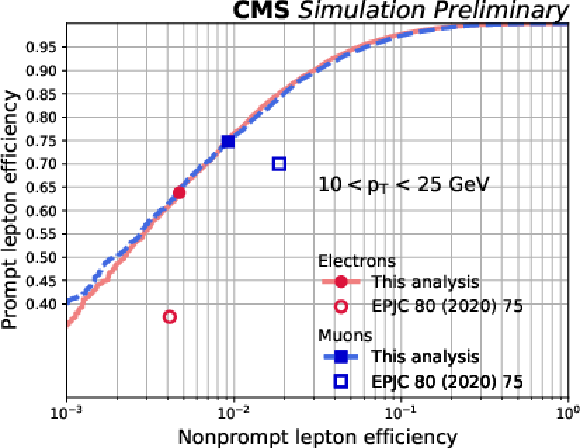
png pdf |
Figure 1-a:
Efficiency of selecting prompt leptons as a function of the misidentification probability for nonprompt leptons evaluated in simulated tˉt events for the electron (red solid line) and muon (blue dashed line) ID BDT, shown for leptons with 10 <pT< 25 GeV (left) and pT> 25 GeV (right). Indicated with filled markers are the efficiencies for the ID criteria applied in this measurement and with empty markers for the ID criteria applied in Ref. [34], where red circles and blue squares are used for electron and muon criteria, respectively. |
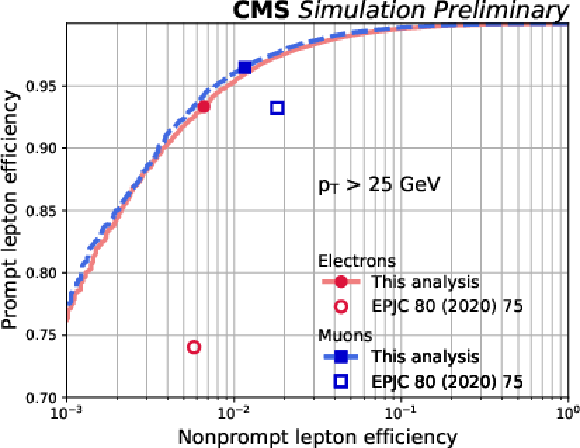
png pdf |
Figure 1-b:
Efficiency of selecting prompt leptons as a function of the misidentification probability for nonprompt leptons evaluated in simulated tˉt events for the electron (red solid line) and muon (blue dashed line) ID BDT, shown for leptons with 10 <pT< 25 GeV (left) and pT> 25 GeV (right). Indicated with filled markers are the efficiencies for the ID criteria applied in this measurement and with empty markers for the ID criteria applied in Ref. [34], where red circles and blue squares are used for electron and muon criteria, respectively. |

png pdf |
Figure 2:
Schematic representation of the event selection and categorization. |
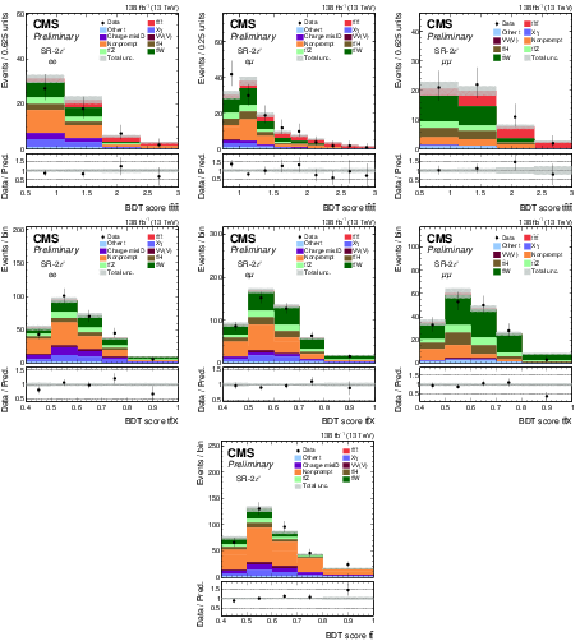
png pdf |
Figure 3:
Comparison of the number of observed (points) and predicted (colored histograms) events in the BDT output distributions for the tˉttˉt signal in the tˉttˉt class (upper row), for the tˉtX background in the tˉtX class (middle row), and for the tˉt background in the tˉt class (lower row) of SR-2ℓ. The tˉttˉt and tˉtX classes are shown separately in the ee (left), eμ (middle) and μμ (right) categories. The vertical bars on the points represent the statistical uncertainties in the data, and the hatched bands the systematic uncertainty in the predictions. The predictions are shown ``postfit'', i.e.,, with the values of the signal and background normalizations and nuisance parameters obtained in the fit to the data applied. |
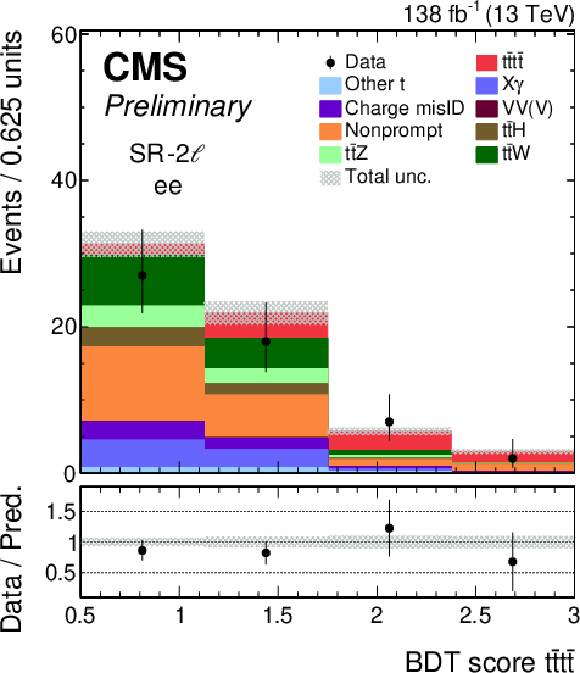
png pdf |
Figure 3-a:
Comparison of the number of observed (points) and predicted (colored histograms) events in the BDT output distributions for the tˉttˉt signal in the tˉttˉt class (upper row), for the tˉtX background in the tˉtX class (middle row), and for the tˉt background in the tˉt class (lower row) of SR-2ℓ. The tˉttˉt and tˉtX classes are shown separately in the ee (left), eμ (middle) and μμ (right) categories. The vertical bars on the points represent the statistical uncertainties in the data, and the hatched bands the systematic uncertainty in the predictions. The predictions are shown ``postfit'', i.e.,, with the values of the signal and background normalizations and nuisance parameters obtained in the fit to the data applied. |
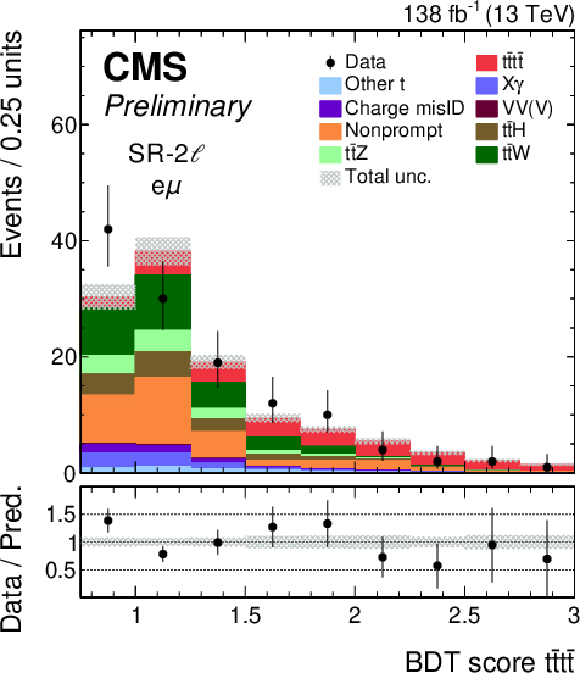
png pdf |
Figure 3-b:
Comparison of the number of observed (points) and predicted (colored histograms) events in the BDT output distributions for the tˉttˉt signal in the tˉttˉt class (upper row), for the tˉtX background in the tˉtX class (middle row), and for the tˉt background in the tˉt class (lower row) of SR-2ℓ. The tˉttˉt and tˉtX classes are shown separately in the ee (left), eμ (middle) and μμ (right) categories. The vertical bars on the points represent the statistical uncertainties in the data, and the hatched bands the systematic uncertainty in the predictions. The predictions are shown ``postfit'', i.e.,, with the values of the signal and background normalizations and nuisance parameters obtained in the fit to the data applied. |

png pdf |
Figure 3-c:
Comparison of the number of observed (points) and predicted (colored histograms) events in the BDT output distributions for the tˉttˉt signal in the tˉttˉt class (upper row), for the tˉtX background in the tˉtX class (middle row), and for the tˉt background in the tˉt class (lower row) of SR-2ℓ. The tˉttˉt and tˉtX classes are shown separately in the ee (left), eμ (middle) and μμ (right) categories. The vertical bars on the points represent the statistical uncertainties in the data, and the hatched bands the systematic uncertainty in the predictions. The predictions are shown ``postfit'', i.e.,, with the values of the signal and background normalizations and nuisance parameters obtained in the fit to the data applied. |
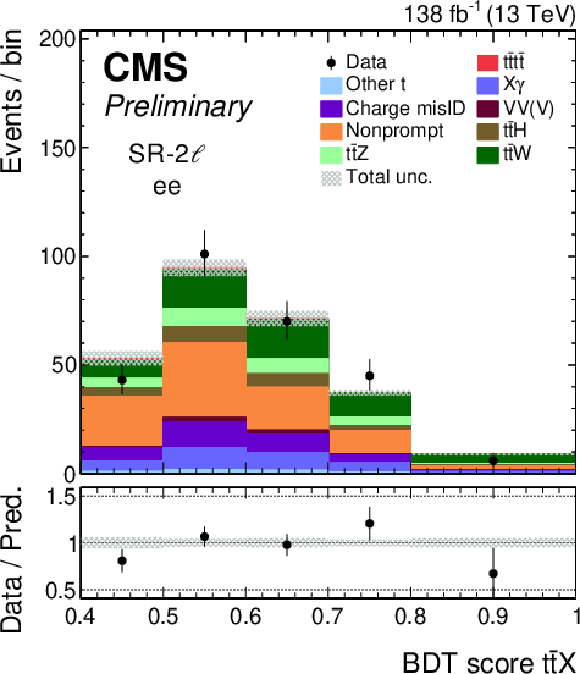
png pdf |
Figure 3-d:
Comparison of the number of observed (points) and predicted (colored histograms) events in the BDT output distributions for the tˉttˉt signal in the tˉttˉt class (upper row), for the tˉtX background in the tˉtX class (middle row), and for the tˉt background in the tˉt class (lower row) of SR-2ℓ. The tˉttˉt and tˉtX classes are shown separately in the ee (left), eμ (middle) and μμ (right) categories. The vertical bars on the points represent the statistical uncertainties in the data, and the hatched bands the systematic uncertainty in the predictions. The predictions are shown ``postfit'', i.e.,, with the values of the signal and background normalizations and nuisance parameters obtained in the fit to the data applied. |
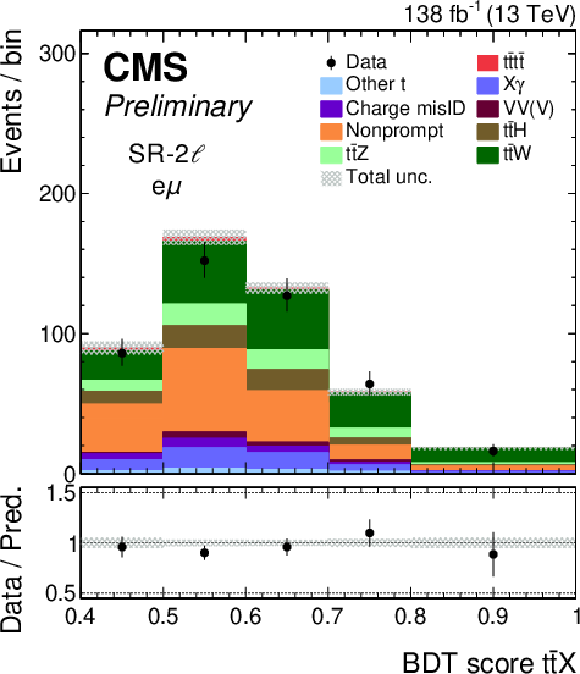
png pdf |
Figure 3-e:
Comparison of the number of observed (points) and predicted (colored histograms) events in the BDT output distributions for the tˉttˉt signal in the tˉttˉt class (upper row), for the tˉtX background in the tˉtX class (middle row), and for the tˉt background in the tˉt class (lower row) of SR-2ℓ. The tˉttˉt and tˉtX classes are shown separately in the ee (left), eμ (middle) and μμ (right) categories. The vertical bars on the points represent the statistical uncertainties in the data, and the hatched bands the systematic uncertainty in the predictions. The predictions are shown ``postfit'', i.e.,, with the values of the signal and background normalizations and nuisance parameters obtained in the fit to the data applied. |

png pdf |
Figure 3-f:
Comparison of the number of observed (points) and predicted (colored histograms) events in the BDT output distributions for the tˉttˉt signal in the tˉttˉt class (upper row), for the tˉtX background in the tˉtX class (middle row), and for the tˉt background in the tˉt class (lower row) of SR-2ℓ. The tˉttˉt and tˉtX classes are shown separately in the ee (left), eμ (middle) and μμ (right) categories. The vertical bars on the points represent the statistical uncertainties in the data, and the hatched bands the systematic uncertainty in the predictions. The predictions are shown ``postfit'', i.e.,, with the values of the signal and background normalizations and nuisance parameters obtained in the fit to the data applied. |
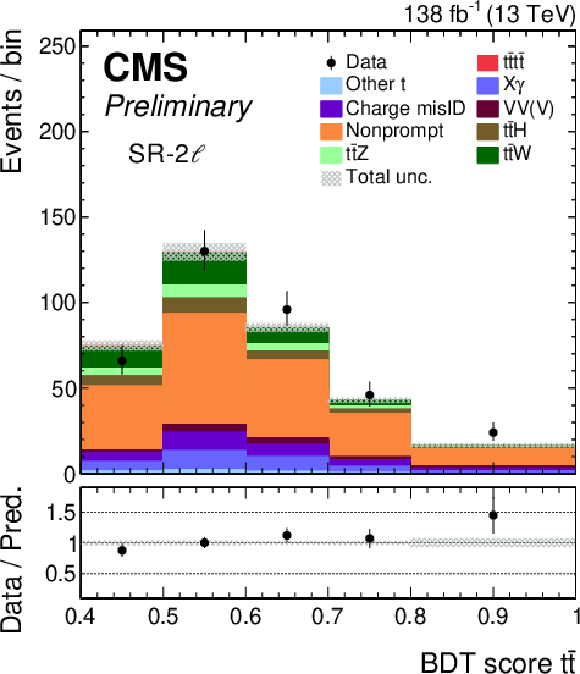
png pdf |
Figure 3-g:
Comparison of the number of observed (points) and predicted (colored histograms) events in the BDT output distributions for the tˉttˉt signal in the tˉttˉt class (upper row), for the tˉtX background in the tˉtX class (middle row), and for the tˉt background in the tˉt class (lower row) of SR-2ℓ. The tˉttˉt and tˉtX classes are shown separately in the ee (left), eμ (middle) and μμ (right) categories. The vertical bars on the points represent the statistical uncertainties in the data, and the hatched bands the systematic uncertainty in the predictions. The predictions are shown ``postfit'', i.e.,, with the values of the signal and background normalizations and nuisance parameters obtained in the fit to the data applied. |
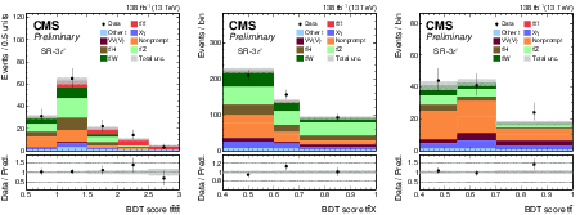
png pdf |
Figure 4:
Comparison of the number of observed (points) and predicted (colored histograms) events in the BDT output distributions for the tˉttˉt signal in the tˉttˉt class (left), for the tˉtX background in the tˉtX class (middle), and for the tˉt background in the tˉt class (right) of SR-3ℓ. The vertical bars on the points represent the statistical uncertainties in the data, and the hatched bands the systematic uncertainty in the predictions. The predictions are shown ``postfit'', i.e.,, with the values of the signal and background normalizations and nuisance parameters obtained in the fit to the data applied. |
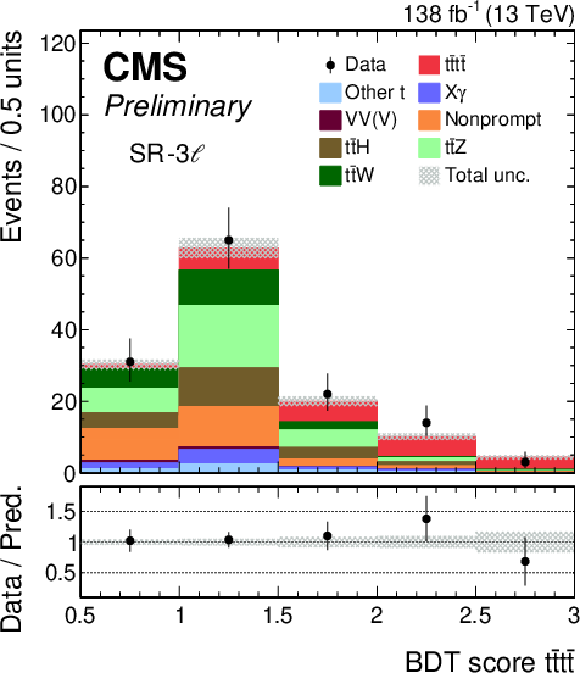
png pdf |
Figure 4-a:
Comparison of the number of observed (points) and predicted (colored histograms) events in the BDT output distributions for the tˉttˉt signal in the tˉttˉt class (left), for the tˉtX background in the tˉtX class (middle), and for the tˉt background in the tˉt class (right) of SR-3ℓ. The vertical bars on the points represent the statistical uncertainties in the data, and the hatched bands the systematic uncertainty in the predictions. The predictions are shown ``postfit'', i.e.,, with the values of the signal and background normalizations and nuisance parameters obtained in the fit to the data applied. |
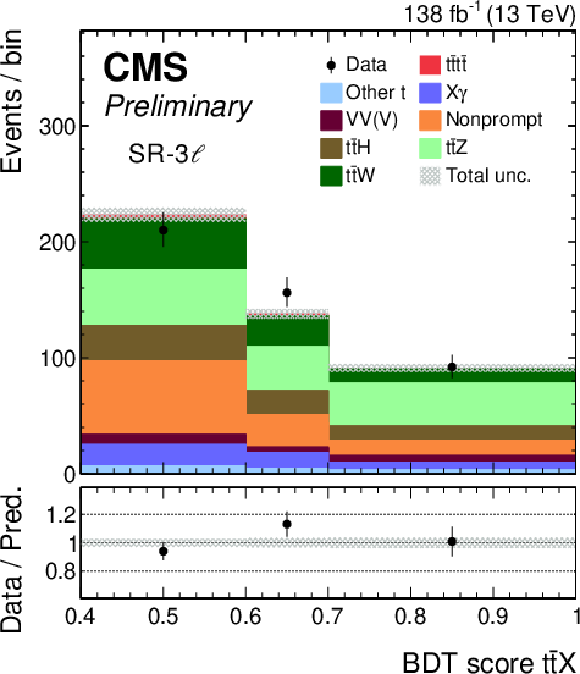
png pdf |
Figure 4-b:
Comparison of the number of observed (points) and predicted (colored histograms) events in the BDT output distributions for the tˉttˉt signal in the tˉttˉt class (left), for the tˉtX background in the tˉtX class (middle), and for the tˉt background in the tˉt class (right) of SR-3ℓ. The vertical bars on the points represent the statistical uncertainties in the data, and the hatched bands the systematic uncertainty in the predictions. The predictions are shown ``postfit'', i.e.,, with the values of the signal and background normalizations and nuisance parameters obtained in the fit to the data applied. |
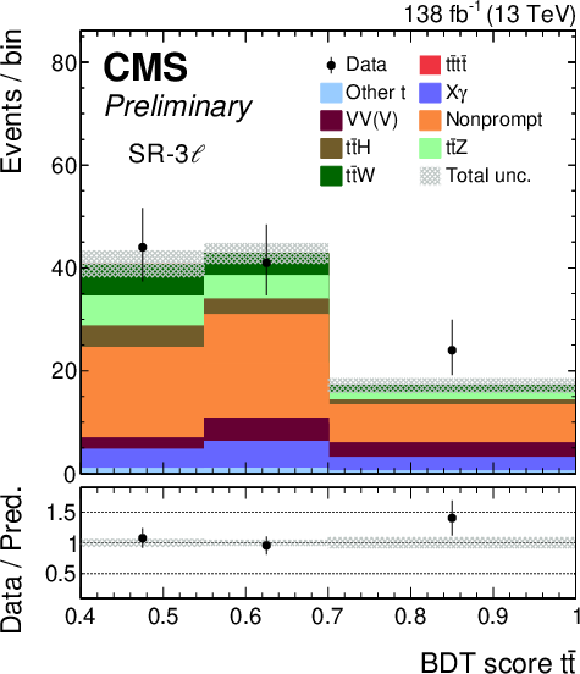
png pdf |
Figure 4-c:
Comparison of the number of observed (points) and predicted (colored histograms) events in the BDT output distributions for the tˉttˉt signal in the tˉttˉt class (left), for the tˉtX background in the tˉtX class (middle), and for the tˉt background in the tˉt class (right) of SR-3ℓ. The vertical bars on the points represent the statistical uncertainties in the data, and the hatched bands the systematic uncertainty in the predictions. The predictions are shown ``postfit'', i.e.,, with the values of the signal and background normalizations and nuisance parameters obtained in the fit to the data applied. |
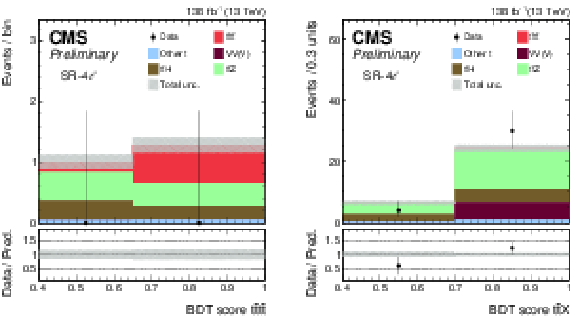
png pdf |
Figure 5:
Comparison of the number of observed (points) and predicted (colored histograms) events in the BDT output distributions for the tˉttˉt signal in the tˉttˉt class (left) and for the tˉtX background in the combined tˉtX and tˉt classes (right) of SR-4ℓ. The vertical bars on the points represent the statistical uncertainties in the data, and the hatched bands the systematic uncertainty in the predictions. The predictions are shown ``postfit'', i.e.,, with the values of the signal and background normalizations and nuisance parameters obtained in the fit to the data applied. No data events are observed in the tˉttˉt class of SR-4ℓ. |
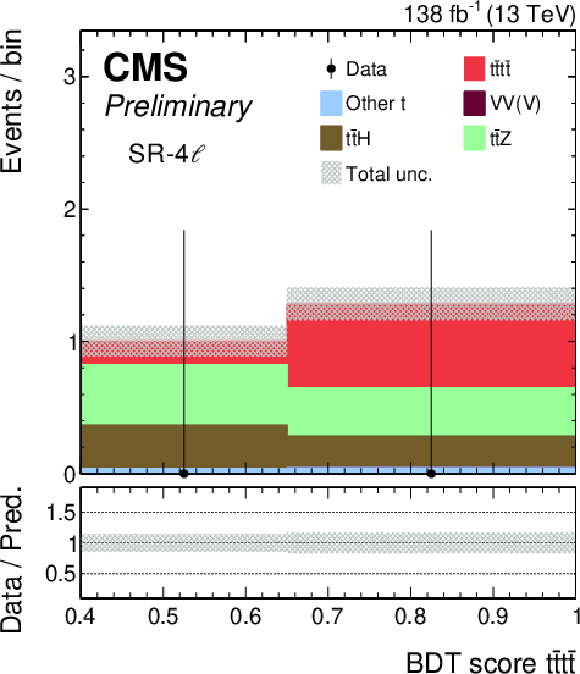
png pdf |
Figure 5-a:
Comparison of the number of observed (points) and predicted (colored histograms) events in the BDT output distributions for the tˉttˉt signal in the tˉttˉt class (left) and for the tˉtX background in the combined tˉtX and tˉt classes (right) of SR-4ℓ. The vertical bars on the points represent the statistical uncertainties in the data, and the hatched bands the systematic uncertainty in the predictions. The predictions are shown ``postfit'', i.e.,, with the values of the signal and background normalizations and nuisance parameters obtained in the fit to the data applied. No data events are observed in the tˉttˉt class of SR-4ℓ. |
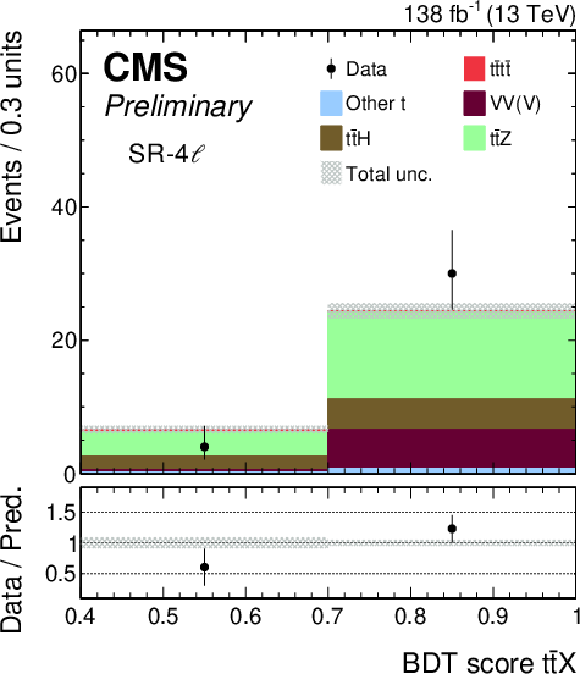
png pdf |
Figure 5-b:
Comparison of the number of observed (points) and predicted (colored histograms) events in the BDT output distributions for the tˉttˉt signal in the tˉttˉt class (left) and for the tˉtX background in the combined tˉtX and tˉt classes (right) of SR-4ℓ. The vertical bars on the points represent the statistical uncertainties in the data, and the hatched bands the systematic uncertainty in the predictions. The predictions are shown ``postfit'', i.e.,, with the values of the signal and background normalizations and nuisance parameters obtained in the fit to the data applied. No data events are observed in the tˉttˉt class of SR-4ℓ. |
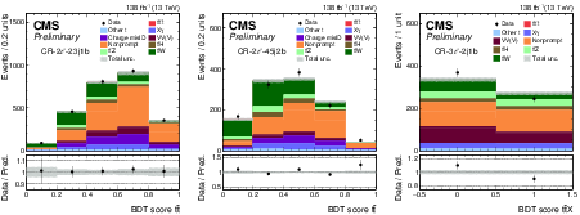
png pdf |
Figure 6:
Comparison of the number of observed (points) and predicted (colored histograms) events in the BDT output distributions for the tˉt background, shown for CR-2ℓ-23j1b (left) and CR-2ℓ-45j2b (middle), and in the event yields with positive and negative sum of lepton charges in CR-3ℓ-2j1b (right). The vertical bars on the points represent the statistical uncertainties in the data, and the hatched bands the systematic uncertainty in the predictions. The predictions are shown ``postfit'', i.e.,, with the values of the signal and background normalizations and nuisance parameters obtained in the fit to the data applied. |

png pdf |
Figure 6-a:
Comparison of the number of observed (points) and predicted (colored histograms) events in the BDT output distributions for the tˉt background, shown for CR-2ℓ-23j1b (left) and CR-2ℓ-45j2b (middle), and in the event yields with positive and negative sum of lepton charges in CR-3ℓ-2j1b (right). The vertical bars on the points represent the statistical uncertainties in the data, and the hatched bands the systematic uncertainty in the predictions. The predictions are shown ``postfit'', i.e.,, with the values of the signal and background normalizations and nuisance parameters obtained in the fit to the data applied. |
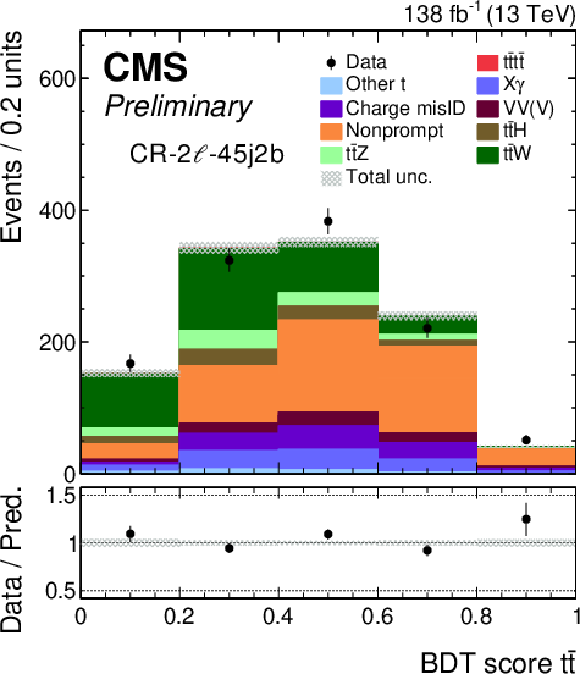
png pdf |
Figure 6-b:
Comparison of the number of observed (points) and predicted (colored histograms) events in the BDT output distributions for the tˉt background, shown for CR-2ℓ-23j1b (left) and CR-2ℓ-45j2b (middle), and in the event yields with positive and negative sum of lepton charges in CR-3ℓ-2j1b (right). The vertical bars on the points represent the statistical uncertainties in the data, and the hatched bands the systematic uncertainty in the predictions. The predictions are shown ``postfit'', i.e.,, with the values of the signal and background normalizations and nuisance parameters obtained in the fit to the data applied. |
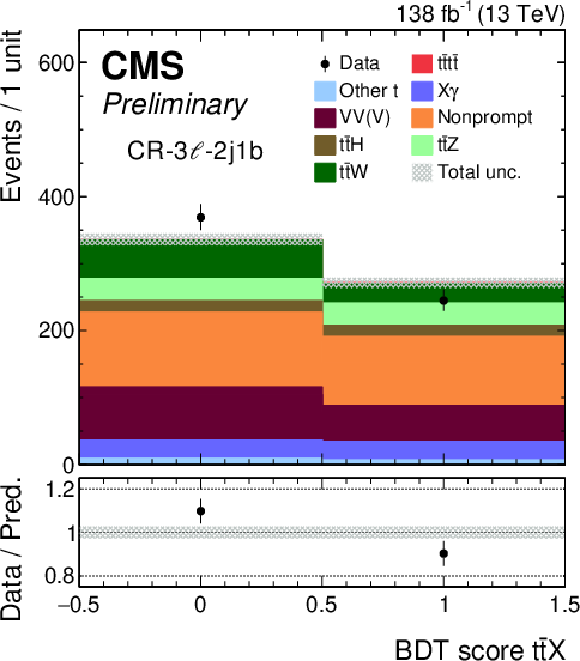
png pdf |
Figure 6-c:
Comparison of the number of observed (points) and predicted (colored histograms) events in the BDT output distributions for the tˉt background, shown for CR-2ℓ-23j1b (left) and CR-2ℓ-45j2b (middle), and in the event yields with positive and negative sum of lepton charges in CR-3ℓ-2j1b (right). The vertical bars on the points represent the statistical uncertainties in the data, and the hatched bands the systematic uncertainty in the predictions. The predictions are shown ``postfit'', i.e.,, with the values of the signal and background normalizations and nuisance parameters obtained in the fit to the data applied. |
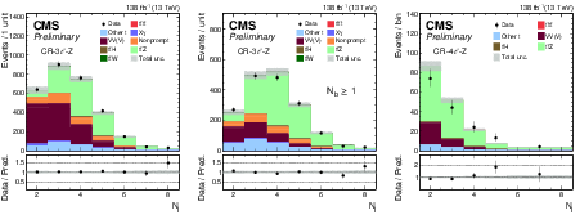
png pdf |
Figure 7:
Comparison of the number of observed (points) and predicted (colored histograms) events in the jet multiplicity distribution, shown for CR-3ℓ-Z (left), CR-3ℓ-Z with the additional requirement of Nb≥ 1 (middle), and CR-4ℓ-Z (right). The vertical bars on the points represent the statistical uncertainties in the data, and the hatched bands the systematic uncertainty in the predictions. The predictions are shown ``postfit'', i.e.,, with the values of the signal and background normalizations and nuisance parameters obtained in the fit to the data applied. |

png pdf |
Figure 7-a:
Comparison of the number of observed (points) and predicted (colored histograms) events in the jet multiplicity distribution, shown for CR-3ℓ-Z (left), CR-3ℓ-Z with the additional requirement of Nb≥ 1 (middle), and CR-4ℓ-Z (right). The vertical bars on the points represent the statistical uncertainties in the data, and the hatched bands the systematic uncertainty in the predictions. The predictions are shown ``postfit'', i.e.,, with the values of the signal and background normalizations and nuisance parameters obtained in the fit to the data applied. |

png pdf |
Figure 7-b:
Comparison of the number of observed (points) and predicted (colored histograms) events in the jet multiplicity distribution, shown for CR-3ℓ-Z (left), CR-3ℓ-Z with the additional requirement of Nb≥ 1 (middle), and CR-4ℓ-Z (right). The vertical bars on the points represent the statistical uncertainties in the data, and the hatched bands the systematic uncertainty in the predictions. The predictions are shown ``postfit'', i.e.,, with the values of the signal and background normalizations and nuisance parameters obtained in the fit to the data applied. |

png pdf |
Figure 7-c:
Comparison of the number of observed (points) and predicted (colored histograms) events in the jet multiplicity distribution, shown for CR-3ℓ-Z (left), CR-3ℓ-Z with the additional requirement of Nb≥ 1 (middle), and CR-4ℓ-Z (right). The vertical bars on the points represent the statistical uncertainties in the data, and the hatched bands the systematic uncertainty in the predictions. The predictions are shown ``postfit'', i.e.,, with the values of the signal and background normalizations and nuisance parameters obtained in the fit to the data applied. |
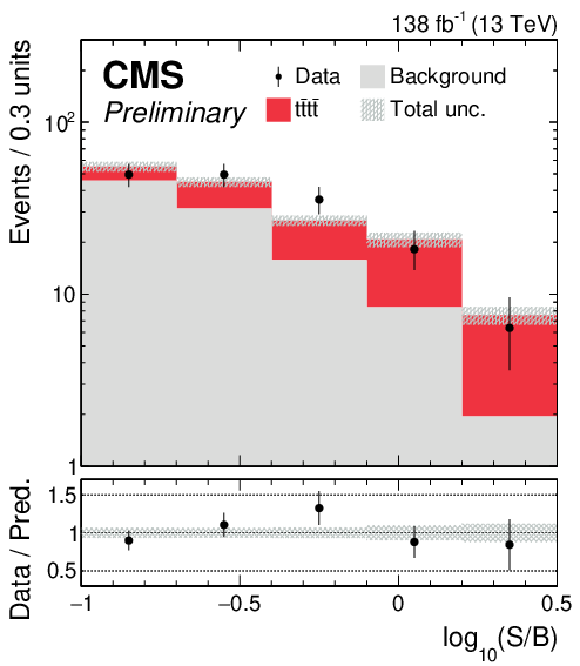
png pdf |
Figure 8:
Comparison of the number of observed (points) and predicted (colored histograms) events as a function of log10(S/B), where S and B are the predicted signal and background yields, respectively, evaluated for each bin in the tˉttˉt classes of the signal regions before the fit to data. Only bins with log10(S/B)>− 1 are included, and bins with log10(S/B)> 0.5 are included in the last bin. The vertical bars on the points represent the statistical uncertainties in the data, and the hatched bands the systematic uncertainty in the predictions. The predictions are shown ``postfit'', i.e.,, with the values of the signal and background normalizations and nuisance parameters obtained in the fit to the data applied. |
| Tables | |
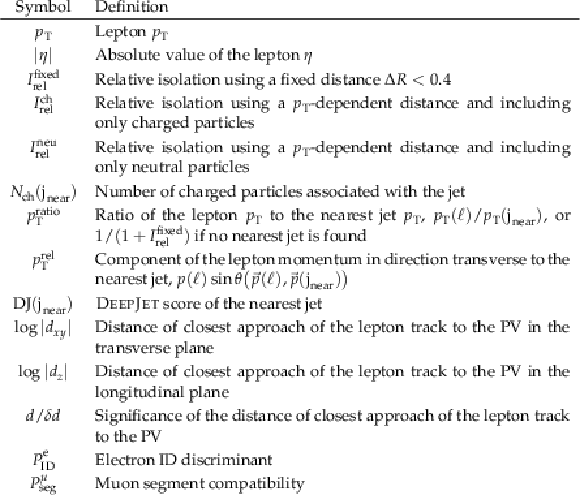
png pdf |
Table 1:
List of the input variables to the prompt-lepton ID BDTs. The nearest jet jnear is defined as the jet that includes the PF particle corresponding to the reconstructed lepton, and its momentum is recalibrated after subtracting the contribution from the lepton. The last two rows list input variables only used in the electron or muon ID BDTs, respectively, and are defined in Refs. [44,45]. |

png pdf |
Table 2:
List of the input variables to the event multiclassification BDTs, sorted by importance in the 2ℓ BDT. Observables not (only) used in the 3 ℓ+4 ℓ BDT are marked with \textdagger (\textdaggerdbl ). The mT2 variable is defined in Ref. [93,94] and constructed from →pmissT and two four-momenta of particle (systems) specified in the table. |
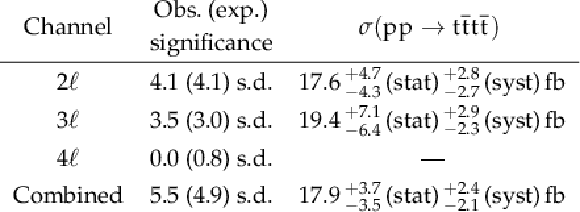
png pdf |
Table 3:
Comparison of fit results in the channels individually and in their combination. |
| Summary |
| In summary, we have reported the first observation for the production of four top quarks (tˉttˉt) in proton-proton (pp) collisions, using events with two same-sign, three, and four charged leptons (electrons and muons) and additional jets. The observed (expected) significance of the tˉttˉt signal above the background-only hypothesis is 5.5 (4.9) standard deviations. The signal cross section is measured to be σ(pp→tˉttˉt)= 17.9 +3.7−3.5 (stat) +2.4−2.1 (syst) $ fb, in agreement with the standard model prediction. |
| Additional Figures | |
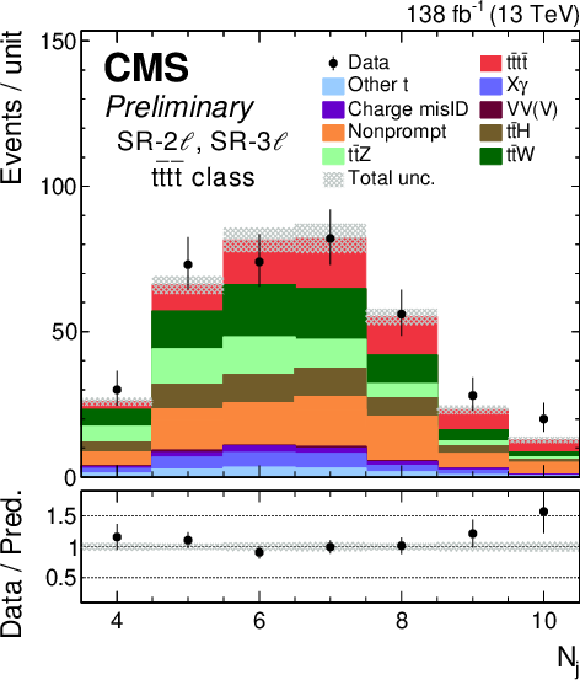
png pdf |
Additional Figure 1:
Comparison of the number of observed (points) and predicted (colored histograms) events in the number of jets distribution, shown for the tˉttˉt class of the combined SR-2ℓ and SR-3ℓ. The vertical bars on the points represent the statistical uncertainties in the data, and the hatched bands the systematic uncertainty in the predictions. The predicted signal and background yields are shown with their best fit normalizations from the simultaneous fit to the data. |
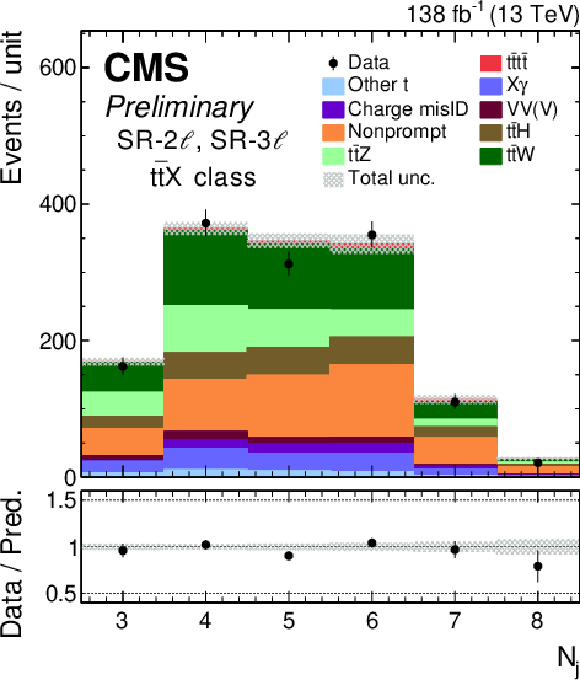
png pdf |
Additional Figure 2:
Comparison of the number of observed (points) and predicted (colored histograms) events in the number of jets distribution, shown for the tˉtX class of the combined SR-2ℓ and SR-3ℓ. The vertical bars on the points represent the statistical uncertainties in the data, and the hatched bands the systematic uncertainty in the predictions. The predicted signal and background yields are shown with their best fit normalizations from the simultaneous fit to the data. |

png pdf |
Additional Figure 3:
Comparison of the number of observed (points) and predicted (colored histograms) events in the number of jets distribution, shown for the tˉt class of the combined SR-2ℓ and SR-3ℓ. The vertical bars on the points represent the statistical uncertainties in the data, and the hatched bands the systematic uncertainty in the predictions. The predicted signal and background yields are shown with their best fit normalizations from the simultaneous fit to the data. |
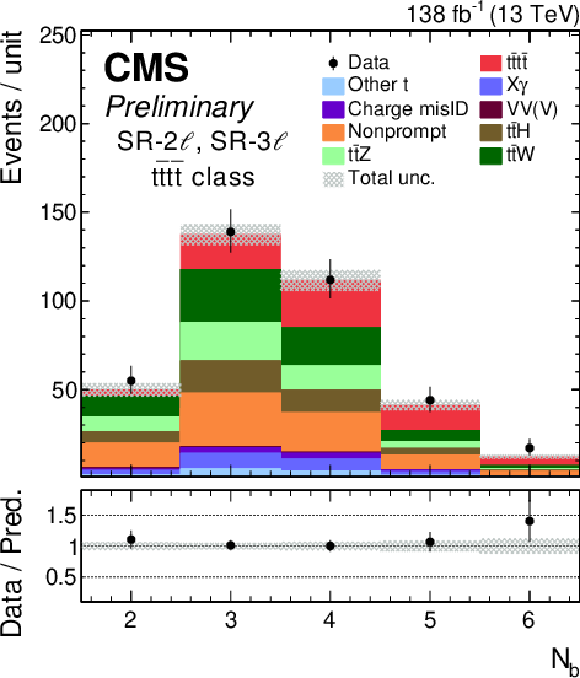
png pdf |
Additional Figure 4:
Comparison of the number of observed (points) and predicted (colored histograms) events in the number of b jets distribution, shown for the tˉttˉt class of the combined SR-2ℓ and SR-3ℓ. The vertical bars on the points represent the statistical uncertainties in the data, and the hatched bands the systematic uncertainty in the predictions. The predicted signal and background yields are shown with their best fit normalizations from the simultaneous fit to the data. |
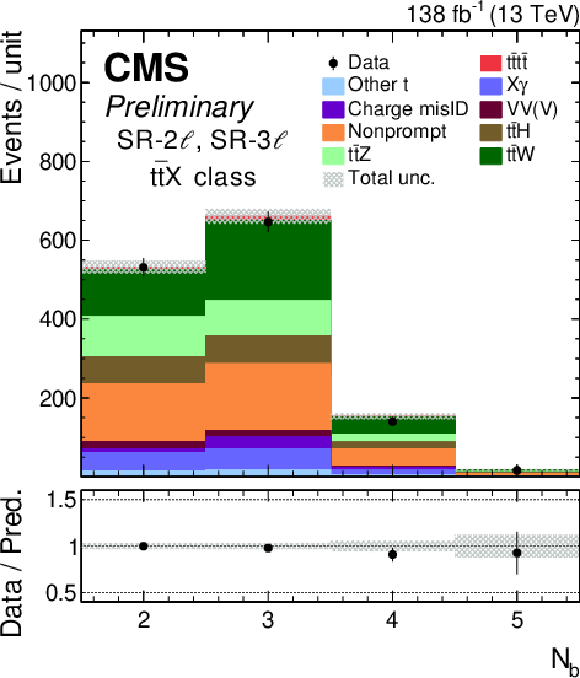
png pdf |
Additional Figure 5:
Comparison of the number of observed (points) and predicted (colored histograms) events in the number of b jets distribution, shown for the tˉtX class of the combined SR-2ℓ and SR-3ℓ. The vertical bars on the points represent the statistical uncertainties in the data, and the hatched bands the systematic uncertainty in the predictions. The predicted signal and background yields are shown with their best fit normalizations from the simultaneous fit to the data. |

png pdf |
Additional Figure 6:
Comparison of the number of observed (points) and predicted (colored histograms) events in the number of b jets distribution, shown for the tˉt class of the combined SR-2ℓ and SR-3ℓ. The vertical bars on the points represent the statistical uncertainties in the data, and the hatched bands the systematic uncertainty in the predictions. The predicted signal and background yields are shown with their best fit normalizations from the simultaneous fit to the data. |
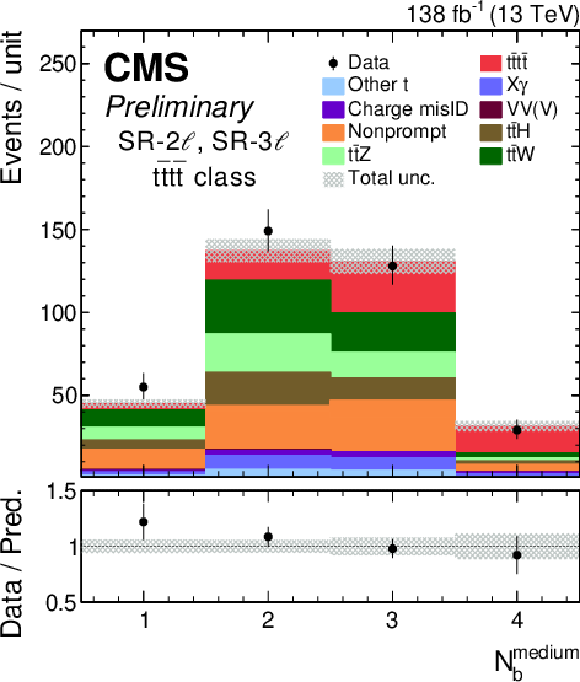
png pdf |
Additional Figure 7:
Comparison of the number of observed (points) and predicted (colored histograms) events in the number of b jets distribution using the "medium" working point for the b jet identification, shown for the tˉttˉt class of the combined SR-2ℓ and SR-3ℓ. The vertical bars on the points represent the statistical uncertainties in the data, and the hatched bands the systematic uncertainty in the predictions. The predicted signal and background yields are shown with their best fit normalizations from the simultaneous fit to the data. |
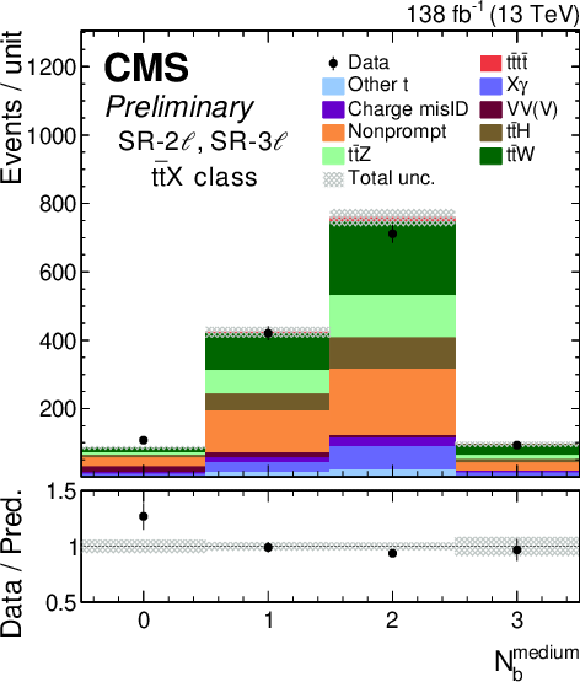
png pdf |
Additional Figure 8:
Comparison of the number of observed (points) and predicted (colored histograms) events in the number of b jets distribution using the "medium" working point for the b jet identification, shown for the tˉtX class of the combined SR-2ℓ and SR-3ℓ. The vertical bars on the points represent the statistical uncertainties in the data, and the hatched bands the systematic uncertainty in the predictions. The predicted signal and background yields are shown with their best fit normalizations from the simultaneous fit to the data. |

png pdf |
Additional Figure 9:
Comparison of the number of observed (points) and predicted (colored histograms) events in the number of b jets distribution using the "medium" working point for the b jet identification, shown for the tˉt class of the combined SR-2ℓ and SR-3ℓ. The vertical bars on the points represent the statistical uncertainties in the data, and the hatched bands the systematic uncertainty in the predictions. The predicted signal and background yields are shown with their best fit normalizations from the simultaneous fit to the data. |

png pdf |
Additional Figure 10:
Comparison of the number of observed (points) and predicted (colored histograms) events in the HT distribution, shown for the tˉttˉt class of the combined SR-2ℓ and SR-3ℓ. The vertical bars on the points represent the statistical uncertainties in the data, and the hatched bands the systematic uncertainty in the predictions. The predicted signal and background yields are shown with their best fit normalizations from the simultaneous fit to the data. |
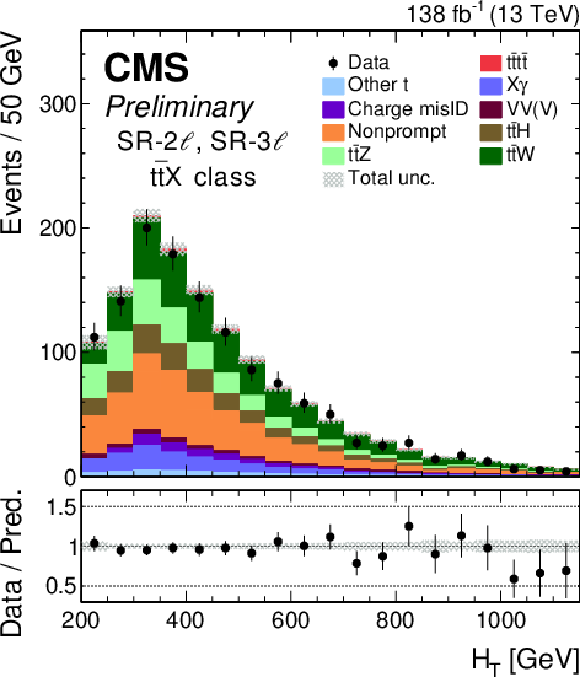
png pdf |
Additional Figure 11:
Comparison of the number of observed (points) and predicted (colored histograms) events in the HT distribution, shown for the tˉtX class of the combined SR-2ℓ and SR-3ℓ. The vertical bars on the points represent the statistical uncertainties in the data, and the hatched bands the systematic uncertainty in the predictions. The predicted signal and background yields are shown with their best fit normalizations from the simultaneous fit to the data. |
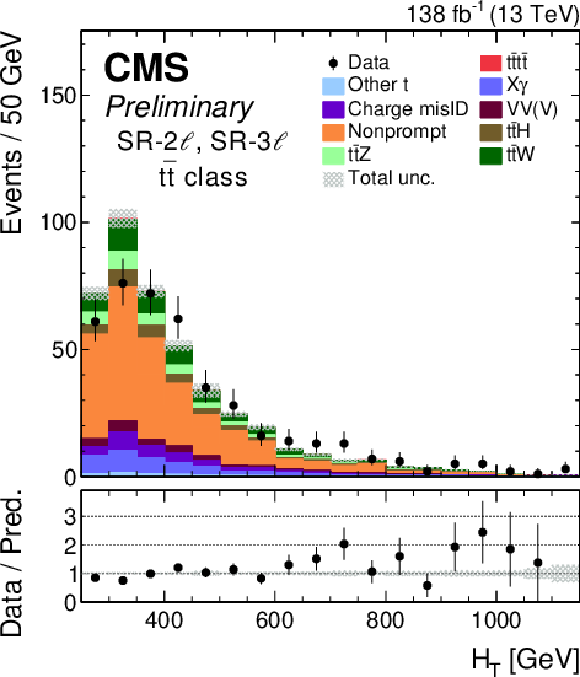
png pdf |
Additional Figure 12:
Comparison of the number of observed (points) and predicted (colored histograms) events in the HT distribution, shown for the tˉt class of the combined SR-2ℓ and SR-3ℓ. The vertical bars on the points represent the statistical uncertainties in the data, and the hatched bands the systematic uncertainty in the predictions. The predicted signal and background yields are shown with their best fit normalizations from the simultaneous fit to the data. |

png pdf |
Additional Figure 13:
Comparison of the number of observed (points) and predicted (colored histograms) events in the pmissT distribution, shown for the tˉttˉt class of the combined SR-2ℓ and SR-3ℓ. The vertical bars on the points represent the statistical uncertainties in the data, and the hatched bands the systematic uncertainty in the predictions. The predicted signal and background yields are shown with their best fit normalizations from the simultaneous fit to the data. |
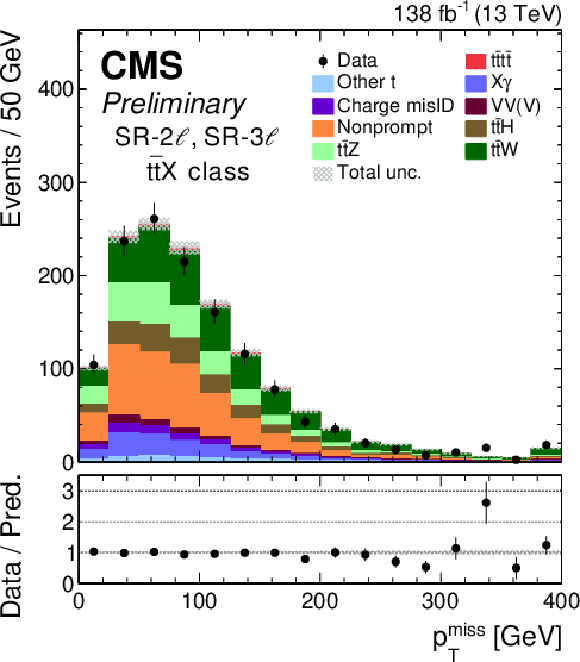
png pdf |
Additional Figure 14:
Comparison of the number of observed (points) and predicted (colored histograms) events in the pmissT distribution, shown for the tˉtX class of the combined SR-2ℓ and SR-3ℓ. The vertical bars on the points represent the statistical uncertainties in the data, and the hatched bands the systematic uncertainty in the predictions. The predicted signal and background yields are shown with their best fit normalizations from the simultaneous fit to the data. |
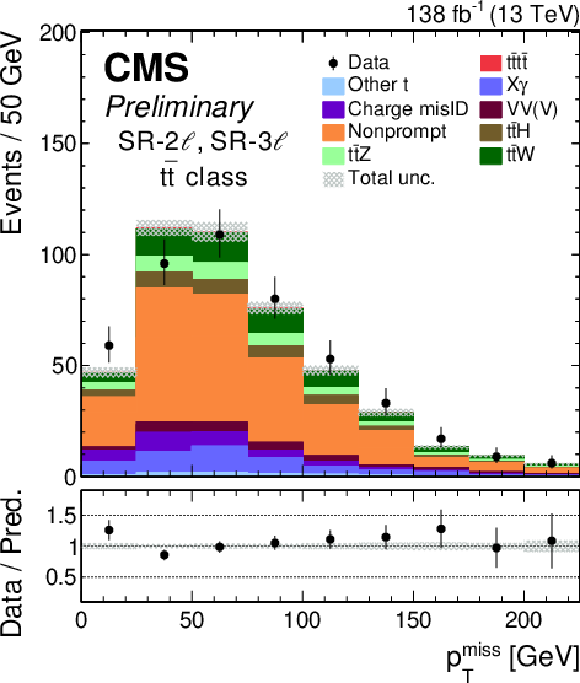
png pdf |
Additional Figure 15:
Comparison of the number of observed (points) and predicted (colored histograms) events in the pmissT distribution, shown for the tˉt class of the combined SR-2ℓ and SR-3ℓ. The vertical bars on the points represent the statistical uncertainties in the data, and the hatched bands the systematic uncertainty in the predictions. The predicted signal and background yields are shown with their best fit normalizations from the simultaneous fit to the data. |
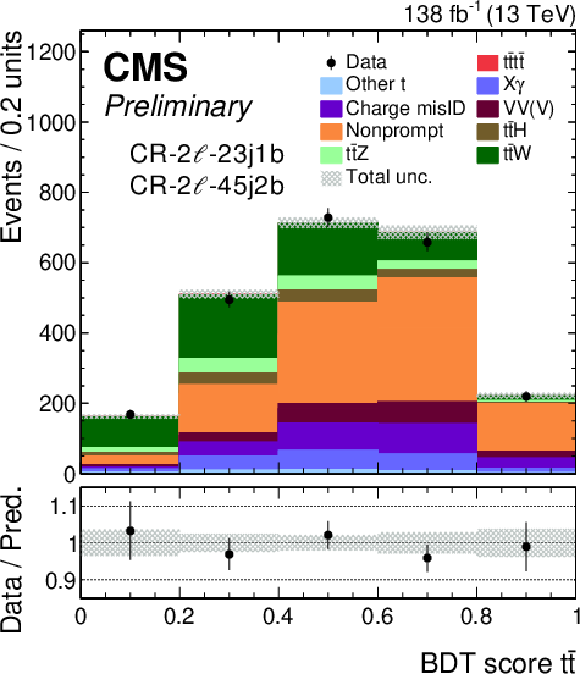
png pdf |
Additional Figure 16:
Comparison of the number of observed (points) and predicted (colored histograms) events in the BDT output distributions for the tˉt background of the combined CR-2ℓ-23j1b and CR-3ℓ-45j2b. The vertical bars on the points represent the statistical uncertainties in the data, and the hatched bands the systematic uncertainty in the predictions. The predicted signal and background yields are shown with their best fit normalizations from the simultaneous fit to the data. |

png pdf |
Additional Figure 17:
Comparison of the number of observed (points) and predicted (colored histograms) events in the number of jets distribution, shown for the CR-3ℓ-Z with the additional requirement of at least one b jet using the "medium" working point for the b jet identification. The vertical bars on the points represent the statistical uncertainties in the data, and the hatched bands the systematic uncertainty in the predictions. The predicted signal and background yields are shown with their best fit normalizations from the simultaneous fit to the data. |

png pdf |
Additional Figure 18:
Comparison of the number of observed (points) and predicted (colored histograms) events in the number of b jets distribution, shown for the CR-3ℓ-Z with the additional requirement of at least one b jet using the "medium" working point for the b jet identification. The vertical bars on the points represent the statistical uncertainties in the data, and the hatched bands the systematic uncertainty in the predictions. The predicted signal and background yields are shown with their best fit normalizations from the simultaneous fit to the data. |

png pdf |
Additional Figure 19:
Comparison of the number of observed (points) and predicted (colored histograms) events in the number of b jets distribution using the "medium" working point for the b jet identification, shown for the CR-3ℓ-Z with the additional requirement of at least one b jet using the "medium" working point for the b jet identification. The vertical bars on the points represent the statistical uncertainties in the data, and the hatched bands the systematic uncertainty in the predictions. The predicted signal and background yields are shown with their best fit normalizations from the simultaneous fit to the data. |
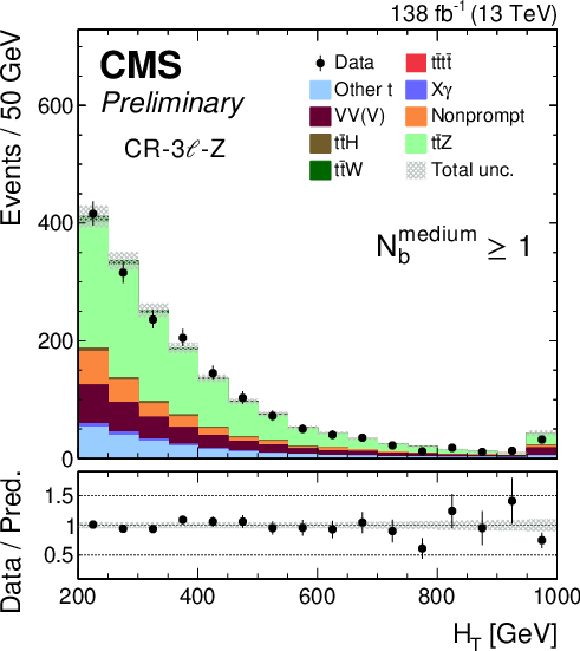
png pdf |
Additional Figure 20:
Comparison of the number of observed (points) and predicted (colored histograms) events in the HT distribution, shown for the CR-3ℓ-Z with the additional requirement of at least one b jet using the "medium" working point for the b jet identification. The vertical bars on the points represent the statistical uncertainties in the data, and the hatched bands the systematic uncertainty in the predictions. The predicted signal and background yields are shown with their best fit normalizations from the simultaneous fit to the data. |

png pdf |
Additional Figure 21:
Comparison of fit results in the channels individually and in their combination. The left panel shows the values of the measured cross section relative to the standard model prediction. The right panel shows the expected and observed significances, with the printed values rounded to the first decimal. |
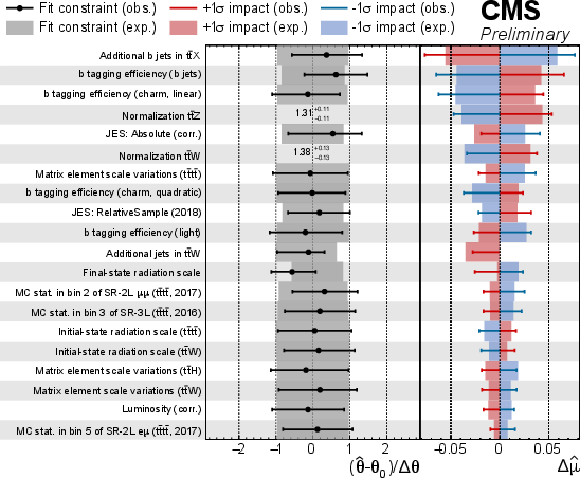
png pdf |
Additional Figure 22:
For the nuisance parameters listed in the left column, the pulls (ˆθ−θ0)/Δθ (middle column) and impacts Δˆμ (right column) are displayed. The 20 nuisance parameters with the largest impacts in the fit used to determine the tˉttˉt cross section are shown. The impact Δˆμ is defined as the shift induced in the signal strength μ when the nuisance parameter θ is varied by ± 1 standard deviation (σ). The pull (ˆθ−θ0)/Δθ is calculated from the values ˆθ and θ0 after and before the fit of θ, respectively, and from its uncertainty Δθ before the fit. The label "correlated" and the per-year labels indicate nuisance parameters associated with the correlated and uncorrelated parts of a systematic uncertainty. The uncertainty for additional jets in tˉtW production has a one-sided template before the fit, and thus a one-sided impact after the fit is expected. |
| References | ||||
| 1 | R. Frederix, D. Pagani, and M. Zaro | Large NLO corrections in t¯tW± and t¯tt¯t hadroproduction from supposedly subleading EW contributions | JHEP 02 (2018) 031 | 1711.02116 |
| 2 | M. van Beekveld, A. Kulesza, and L. Moreno Valero | Threshold resummation for the production of four top quarks at the LHC | 2212.03259 | |
| 3 | ATLAS Collaboration | The ATLAS experiment at the CERN Large Hadron Collider | JINST 3 (2008) S08003 | |
| 4 | CMS Collaboration | The CMS experiment at the CERN LHC | JINST 3 (2008) S08004 | |
| 5 | Q.-H. Cao, S.-L. Chen, and Y. Liu | Probing Higgs width and top quark Yukawa coupling from t¯tH and t¯tt¯t productions | PRD 95 (2017) 053004 | 1602.01934 |
| 6 | Q.-H. Cao et al. | Limiting top quark-Higgs boson interaction and Higgs-boson width from multitop productions | PRD 99 (2019) 113003 | 1901.04567 |
| 7 | D. Dicus, A. Stange, and S. Willenbrock | Higgs decay to top quarks at hadron colliders | PLB 333 (1994) 126 | hep-ph/9404359 |
| 8 | N. Craig et al. | The hunt for the rest of the Higgs bosons | JHEP 06 (2015) 137 | 1504.04630 |
| 9 | N. Craig et al. | Heavy Higgs bosons at low tanβ: from the LHC to 100 TeV | JHEP 01 (2017) 018 | 1605.08744 |
| 10 | Anisha et al. | On the BSM reach of four top production at the LHC | Submitted to JHEP, 2023 | 2302.08281 |
| 11 | H. Nilles | Supersymmetry, supergravity and particle physics | Phys. Rept. 110 (1984) 1 | |
| 12 | G. Farrar and P. Fayet | Phenomenology of the production, decay, and detection of new hadronic states associated with supersymmetry | PLB 76 (1978) 575 | |
| 13 | M. Toharia and J. Wells | Gluino decays with heavier scalar superpartners | JHEP 02 (2006) 015 | hep-ph/0503175 |
| 14 | T. Plehn and T. Tait | Seeking sgluons | JPG 36 (2009) 075001 | 0810.3919 |
| 15 | S. Calvet, B. Fuks, P. Gris, and L. Valery | Searching for sgluons in multitop events at a center-of-mass energy of 8 TeV | JHEP 04 (2013) 043 | 1212.3360 |
| 16 | L. Beck et al. | Probing top-philic sgluons with LHC Run I data | PLB 746 (2015) 48 | 1501.07580 |
| 17 | L. Darmé , B. Fuks, and M. Goodsell | Cornering sgluons with four-top-quark events | PLB 784 (2018) 223 | 1805.10835 |
| 18 | K. Kumar, T. M. P. Tait, and R. Vega-Morales | Manifestations of top compositeness at colliders | JHEP 05 (2009) 022 | 0901.3808 |
| 19 | G. Cacciapaglia et al. | Composite scalars at the LHC: the Higgs, the sextet and the octet | JHEP 11 (2015) 201 | 1507.02283 |
| 20 | O. Ducu, L. Heurtier, and J. Maurer | LHC signatures of a Z′ mediator between dark matter and the SU(3) sector | JHEP 03 (2016) 006 | 1509.05615 |
| 21 | C. Degrande et al. | Non-resonant new physics in top pair production at hadron colliders | JHEP 03 (2011) 125 | 1010.6304 |
| 22 | C. Zhang | Constraining qqtt operators from four-top production: a case for enhanced EFT sensitivity | Chin. Phys. C 42 (2018) 023104 | 1708.05928 |
| 23 | N. Hartland et al. | A Monte Carlo global analysis of the standard model effective field theory: the top quark sector | JHEP 04 (2019) 100 | 1901.05965 |
| 24 | C. Englert, G. F. Giudice, A. Greljo, and M. Mccullough | The ˆH-parameter: an oblique Higgs view | JHEP 09 (2019) 041 | 1903.07725 |
| 25 | G. Banelli et al. | The present and future of four top operators | JHEP 02 (2021) 043 | 2010.05915 |
| 26 | L. Darmé , B. Fuks, and F. Maltoni | Top-philic heavy resonances in four-top final states and their EFT interpretation | JHEP 09 (2021) 143 | 2104.09512 |
| 27 | SMEFiT Collaboration | Combined SMEFT interpretation of Higgs, diboson, and top quark data from the LHC | JHEP 11 (2021) 089 | 2105.00006 |
| 28 | R. Aoude, H. El Faham, F. Maltoni, and E. Vryonidou | Complete SMEFT predictions for four top quark production at hadron colliders | JHEP 10 (2022) 163 | 2208.04962 |
| 29 | CMS Collaboration | Search for physics beyond the standard model in events with two leptons of same sign, missing transverse momentum, and jets in proton-proton collisions at √s= 13 TeV | EPJC 77 (2017) 578 | CMS-SUS-16-035 1704.07323 |
| 30 | CMS Collaboration | Search for standard model production of four top quarks with same-sign and multilepton final states in proton-proton collisions at √s= 13 TeV | EPJC 78 (2018) 140 | CMS-TOP-17-009 1710.10614 |
| 31 | ATLAS Collaboration | Search for new phenomena in events with same-charge leptons and b jets in pp collisions at √s= 13 TeV with the ATLAS detector | JHEP 12 (2018) 039 | 1807.11883 |
| 32 | ATLAS Collaboration | Search for four-top-quark production in the single-lepton and opposite-sign dilepton final states in pp collisions at √s= 13 TeV with the ATLAS detector | PRD 99 (2019) 052009 | 1811.02305 |
| 33 | CMS Collaboration | Search for the production of four top quarks in the single-lepton and opposite-sign dilepton final states in proton-proton collisions at √s= 13 TeV | JHEP 11 (2019) 082 | CMS-TOP-17-019 1906.02805 |
| 34 | CMS Collaboration | Search for production of four top quarks in final states with same-sign or multiple leptons in proton-proton collisions at √s= 13 TeV | EPJC 80 (2020) 75 | CMS-TOP-18-003 1908.06463 |
| 35 | ATLAS Collaboration | Evidence for t¯tt¯t production in the multilepton final state in proton-proton collisions at √s= 13 TeV with the ATLAS detector | EPJC 80 (2020) 1085 | 2007.14858 |
| 36 | ATLAS Collaboration | Measurement of the t¯tt¯t production cross section in pp collisions at √s= 13 TeV with the ATLAS detector | JHEP 11 (2021) 118 | 2106.11683 |
| 37 | CMS Collaboration | Evidence for four-top quark production in proton-proton collisions at √s= 13 TeV | Submitted to Phys. Lett. B, 2023 | CMS-TOP-21-005 2303.03864 |
| 38 | F. Blekman, F. Déliot, V. Dutta, and E. Usai | Four-top quark physics at the LHC | Universe 8 (2022) 638 | 2208.04085 |
| 39 | CMS Collaboration | Precision luminosity measurement in proton-proton collisions at √s= 13 TeV in 2015 and 2016 at CMS | EPJC 81 (2021) 800 | CMS-LUM-17-003 2104.01927 |
| 40 | CMS Collaboration | CMS luminosity measurement for the 2017 data-taking period at √s= 13 TeV | CMS Physics Analysis Summary, 2018 CMS-PAS-LUM-17-004 |
CMS-PAS-LUM-17-004 |
| 41 | CMS Collaboration | CMS luminosity measurement for the 2018 data-taking period at √s= 13 TeV | CMS Physics Analysis Summary, 2019 CMS-PAS-LUM-18-002 |
CMS-PAS-LUM-18-002 |
| 42 | CMS Collaboration | Performance of the CMS Level-1 trigger in proton-proton collisions at √s= 13 TeV | JINST 15 (2020) P10017 | CMS-TRG-17-001 2006.10165 |
| 43 | CMS Collaboration | The CMS trigger system | JINST 12 (2017) P01020 | CMS-TRG-12-001 1609.02366 |
| 44 | CMS Collaboration | Electron and photon reconstruction and identification with the CMS experiment at the CERN LHC | JINST 16 (2021) P05014 | CMS-EGM-17-001 2012.06888 |
| 45 | CMS Collaboration | Performance of the CMS muon detector and muon reconstruction with proton-proton collisions at √s= 13 TeV | JINST 13 (2018) P06015 | CMS-MUO-16-001 1804.04528 |
| 46 | CMS Collaboration | Description and performance of track and primary-vertex reconstruction with the CMS tracker | JINST 9 (2014) P10009 | CMS-TRK-11-001 1405.6569 |
| 47 | CMS Collaboration | Particle-flow reconstruction and global event description with the CMS detector | JINST 12 (2017) P10003 | CMS-PRF-14-001 1706.04965 |
| 48 | CMS Collaboration | Performance of reconstruction and identification of τ leptons decaying to hadrons and ντ in pp collisions at √s= 13 TeV | JINST 13 (2018) P10005 | CMS-TAU-16-003 1809.02816 |
| 49 | CMS Collaboration | Performance of the CMS missing transverse momentum reconstruction in pp data at √s= 8 TeV | JINST 10 (2015) P02006 | CMS-JME-13-003 1411.0511 |
| 50 | CMS Collaboration | Performance of missing transverse momentum reconstruction in proton-proton collisions at √s= 13 TeV using the CMS detector | JINST 14 (2019) P07004 | CMS-JME-17-001 1903.06078 |
| 51 | M. Cacciari, G. P. Salam, and G. Soyez | The anti-kT jet clustering algorithm | JHEP 04 (2008) 063 | 0802.1189 |
| 52 | M. Cacciari, G. P. Salam, and G. Soyez | FASTJET user manual | EPJC 72 (2012) 1896 | 1111.6097 |
| 53 | CMS Collaboration | Jet energy scale and resolution in the CMS experiment in collisions at 8 TeV | JINST 12 (2017) P02014 | CMS-JME-13-004 1607.03663 |
| 54 | CMS Collaboration | Identification of heavy-flavour jets with the CMS detector in pp collisions at 13 TeV | JINST 13 (2018) P05011 | CMS-BTV-16-002 1712.07158 |
| 55 | CMS Collaboration | Performance of the DeepJet b tagging algorithm using 41.9 fb−1 of data from proton-proton collisions at 13 TeV with Phase 1 CMS detector | CMS Detector Performance Note CMS-DP-2018-058, 2018 CDS |
|
| 56 | E. Bols et al. | Jet flavour classification using DeepJet | JINST 15 (2020) P12012 | 2008.10519 |
| 57 | CMS Collaboration | Technical proposal for the Phase-II upgrade of the Compact Muon Solenoid | CMS Technical Proposal CERN-LHCC-2015-010, CMS-TDR-15-02 CDS |
|
| 58 | CMS Collaboration | ECAL 2016 refined calibration and Run2 summary plots | CMS Detector Performance Note CMS-DP-2020-021, 2020 CDS |
|
| 59 | K. Rehermann and B. Tweedie | Efficient identification of boosted semileptonic top quarks at the LHC | JHEP 03 (2011) 059 | 1007.2221 |
| 60 | T. Chen and C. Guestrin | \textscXGBoost: A scalable tree boosting system | in 22nd ACM SIGKDD Int. Conf. on Knowledge Discovery and Data Mining, San Francisco, 2016 Proc. 2 (2016) 2 |
1603.02754 |
| 61 | CMS Collaboration | Evidence for associated production of a Higgs boson with a top quark pair in final states with electrons, muons, and hadronically decaying τ leptons at √s= 13 TeV | JHEP 08 (2018) 066 | CMS-HIG-17-018 1803.05485 |
| 62 | CMS Collaboration | Observation of single top quark production in association with a Z boson in proton-proton collisions at √s= 13 TeV | PRL 122 (2019) 132003 | CMS-TOP-18-008 1812.05900 |
| 63 | CMS Collaboration | Measurement of the Higgs boson production rate in association with top quarks in final states with electrons, muons, and hadronically decaying tau leptons at √s= 13 TeV | EPJC 81 (2021) 378 | CMS-HIG-19-008 2011.03652 |
| 64 | CMS Collaboration | Search for electroweak production of charginos and neutralinos in proton-proton collisions at √s= 13 TeV | JHEP 04 (2022) 147 | CMS-SUS-19-012 2106.14246 |
| 65 | CMS Collaboration | Measurements of the electroweak diboson production cross sections in proton-proton collisions at √s= 5.02 TeV using leptonic decays | PRL 127 (2021) 191801 | CMS-SMP-20-012 2107.01137 |
| 66 | CMS Collaboration | Inclusive and differential cross section measurements of single top quark production in association with a Z boson in proton-proton collisions at √s= 13 TeV | JHEP 02 (2022) 107 | CMS-TOP-20-010 2111.02860 |
| 67 | CMS Collaboration | Performance of electron reconstruction and selection with the CMS detector in proton-proton collisions at √s= 8 TeV | JINST 10 (2015) P06005 | CMS-EGM-13-001 1502.02701 |
| 68 | CMS Collaboration | Performance of CMS muon reconstruction in cosmic-ray events | JINST 5 (2010) T03022 | CMS-CFT-09-014 0911.4994 |
| 69 | CMS Collaboration | Performance of the reconstruction and identification of high-momentum muons in proton-proton collisions at √s= 13 TeV | JINST 15 (2020) P02027 | CMS-MUO-17-001 1912.03516 |
| 70 | J. Alwall et al. | The automated computation of tree-level and next-to-leading order differential cross sections, and their matching to parton shower simulations | JHEP 07 (2014) 079 | 1405.0301 |
| 71 | P. Artoisenet, R. Frederix, O. Mattelaer, and R. Rietkerk | Automatic spin-entangled decays of heavy resonances in Monte Carlo simulations | JHEP 03 (2013) 015 | 1212.3460 |
| 72 | P. Nason | A new method for combining NLO QCD with shower Monte Carlo algorithms | JHEP 11 (2004) 040 | hep-ph/0409146 |
| 73 | S. Frixione, G. Ridolfi, and P. Nason | A positive-weight next-to-leading-order Monte Carlo for heavy flavour hadroproduction | JHEP 09 (2007) 126 | 0707.3088 |
| 74 | S. Frixione, P. Nason, and C. Oleari | Matching NLO QCD computations with parton shower simulations: the POWHEG method | JHEP 11 (2007) 070 | 0709.2092 |
| 75 | S. Alioli, P. Nason, C. Oleari, and E. Re | NLO single-top production matched with shower in POWHEG: s- and t-channel contributions | JHEP 09 (2009) 111 | 0907.4076 |
| 76 | P. Nason and C. Oleari | NLO Higgs boson production via vector-boson fusion matched with shower in POWHEG | JHEP 02 (2010) 037 | 0911.5299 |
| 77 | S. Alioli, P. Nason, C. Oleari, and E. Re | A general framework for implementing NLO calculations in shower Monte Carlo programs: the POWHEG BOX | JHEP 06 (2010) 043 | 1002.2581 |
| 78 | E. Re | Single-top Wt-channel production matched with parton showers using the POWHEG method | EPJC 71 (2011) 1547 | 1009.2450 |
| 79 | E. Bagnaschi, G. Degrassi, P. Slavich, and A. Vicini | Higgs production via gluon fusion in the POWHEG approach in the SM and in the MSSM | JHEP 02 (2012) 088 | 1111.2854 |
| 80 | P. Nason and G. Zanderighi | W+W−, WZ and ZZ production in the POWHEG-BOX-v2 | EPJC 74 (2014) 2702 | 1311.1365 |
| 81 | J. M. Campbell and R. K. Ellis | An update on vector boson pair production at hadron colliders | PRD 60 (1999) 113006 | hep-ph/9905386 |
| 82 | J. M. Campbell, R. K. Ellis, and C. Williams | Vector boson pair production at the LHC | JHEP 07 (2011) 018 | 1105.0020 |
| 83 | J. M. Campbell, R. K. Ellis, and W. T. Giele | A multi-threaded version of MCFM | EPJC 75 (2015) 246 | 1503.06182 |
| 84 | NNPDF Collaboration | Parton distributions from high-precision collider data | EPJC 77 (2017) 663 | 1706.00428 |
| 85 | T. Sjöstrand et al. | An introduction to PYTHIA8.2 | Comput. Phys. Commun. 191 (2015) 159 | 1410.3012 |
| 86 | CMS Collaboration | Extraction and validation of a new set of CMS PYTHIA8 tunes from underlying-event measurements | EPJC 80 (2020) 4 | CMS-GEN-17-001 1903.12179 |
| 87 | R. Frederix and S. Frixione | Merging meets matching in MC@NLO | JHEP 12 (2012) 061 | 1209.6215 |
| 88 | J. Alwall et al. | Comparative study of various algorithms for the merging of parton showers and matrix elements in hadronic collisions | EPJC 53 (2008) 473 | 0706.2569 |
| 89 | S. Bolognesi et al. | On the spin and parity of a single-produced resonance at the LHC | PRD 86 (2012) 095031 | 1208.4018 |
| 90 | GEANT4 Collaboration | GEANT 4---a simulation toolkit | NIM A 506 (2003) 250 | |
| 91 | Particle Data Group , R. L. Workman et al. | Review of particle physics | Prog. Theor. Exp. Phys. 2022 (2022) 083C01 | |
| 92 | H. Voss, A. Höcker, J. Stelzer, and F. Tegenfeldt | TMVA, the toolkit for multivariate data analysis with ROOT | in 11th Int. Workshop on Advanced Computing and Analysis Techniques in Phys. Research (ACAT ), Amsterdam, 2017 Proc. 1 (2017) 1 |
physics/0703039 |
| 93 | C. G. Lester and D. J. Summers | Measuring masses of semiinvisibly decaying particles pair produced at hadron colliders | PLB 463 (1999) 99 | hep-ph/9906349 |
| 94 | C. G. Lester | The stransverse mass, mT2, in special cases | JHEP 05 (2011) 076 | 1103.5682 |
| 95 | A. Kulesza et al. | Associated top quark pair production with a heavy boson: differential cross sections at NLO+NNLL accuracy | EPJC 80 (2020) 428 | 2001.03031 |
| 96 | R. Frederix and I. Tsinikos | On improving NLO merging for t¯tW production | JHEP 11 (2021) 029 | 2108.07826 |
| 97 | CMS Collaboration | Measurement of the associated production of a single top quark and a Z boson in pp collisions at √s= 13 TeV | PLB 779 (2018) 358 | CMS-TOP-16-020 1712.02825 |
| 98 | CMS Collaboration | Search for new physics in same-sign dilepton events in proton-proton collisions at √s= 13 TeV | EPJC 76 (2016) 439 | CMS-SUS-15-008 1605.03171 |
| 99 | CMS Collaboration | Measurements of inclusive W and Z cross sections in pp collisions at √s= 7 TeV | JHEP 01 (2011) 080 | CMS-EWK-10-002 1012.2466 |
| 100 | CMS Collaboration | Measurements of the pp→WZ inclusive and differential production cross section and constraints on charged anomalous triple gauge couplings at √s= 13 TeV | JHEP 04 (2019) 122 | CMS-SMP-18-002 1901.03428 |
| 101 | CMS Collaboration | Measurements of the pp→ZZ production cross section and the Z→4ℓ branching fraction, and constraints on anomalous triple gauge couplings at √s= 13 TeV | EPJC 78 (2018) 165 | CMS-SMP-16-017 1709.08601 |
| 102 | CMS Collaboration | W+W− boson pair production in proton-proton collisions at √s= 13 TeV | PRD 102 (2020) 092001 | CMS-SMP-18-004 2009.00119 |
| 103 | CMS Collaboration | Measurement of the inclusive and differential t¯tγ cross sections in the dilepton channel and effective field theory interpretation in proton-proton collisions at √s= 13 TeV | JHEP 05 (2022) 091 | CMS-TOP-21-004 2201.07301 |
| 104 | J. Butterworth et al. | PDF4LHC recommendations for LHC Run II | JPG 43 (2016) 023001 | 1510.03865 |
| 105 | CMS Collaboration | Measurement of the cross section for t¯t production with additional jets and b jets in pp collisions at √s= 13 TeV | JHEP 07 (2020) 125 | CMS-TOP-18-002 2003.06467 |
| 106 | CMS Collaboration | Inclusive and differential cross section measurements of t¯tb¯b production in the lepton+jets channel at √s= 13 TeV with the cms detector | CMS Physics Analysis Summary, 2023 CMS-PAS-TOP-22-009 |
CMS-PAS-TOP-22-009 |
| 107 | CMS Collaboration | Precise determination of the mass of the Higgs boson and tests of compatibility of its couplings with the standard model predictions using proton collisions at 7 and 8 TeV | EPJC 75 (2015) 212 | CMS-HIG-14-009 1412.8662 |
| 108 | R. Barlow and C. Beeston | Fitting using finite Monte Carlo samples | Comput. Phys. Commun. 77 (1993) 219 | |
| 109 | J. S. Conway | Incorporating nuisance parameters in likelihoods for multisource spectra | in Workshop on Statistical Issues Related to Discovery Claims in Search Experiments and Unfolding (PHYSTAT ): Geneva, 2011 link |
1103.0354 |
| 110 | ATLAS and CMS Collaborations, and LHC Higgs Combination Group | Procedure for the LHC Higgs boson search combination in Summer 2011 | Technical Report CMS-NOTE-2011-005, ATL-PHYS-PUB-2011-11, 2011 | |
| 111 | G. Cowan, K. Cranmer, E. Gross, and O. Vitells | Asymptotic formulae for likelihood-based tests of new physics | EPJC 71 (2011) 1554 | 1007.1727 |

|
Compact Muon Solenoid LHC, CERN |

|

|

|

|

|

|